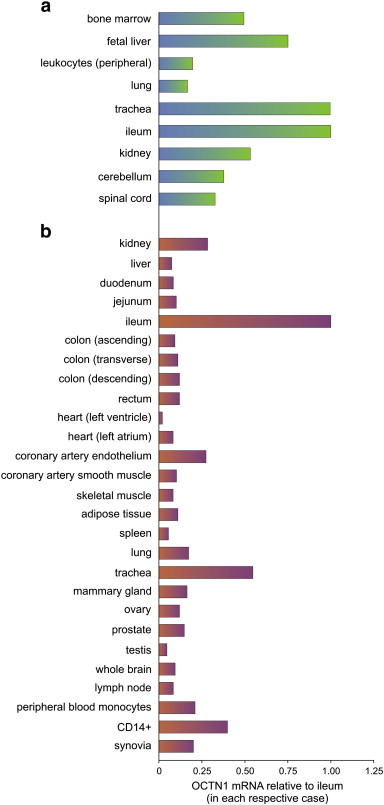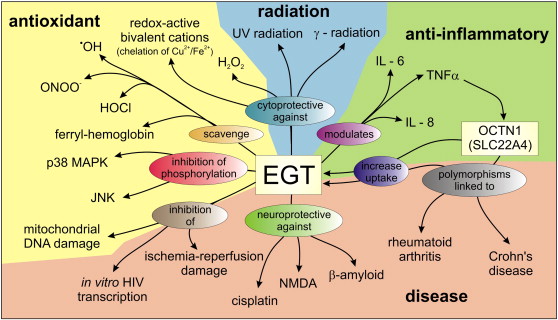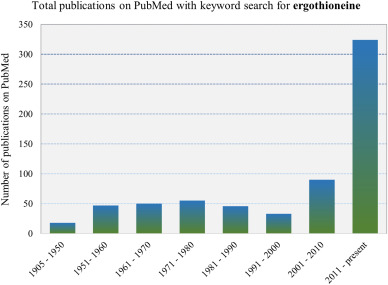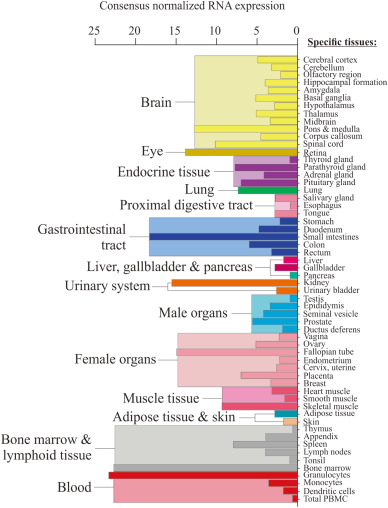Ergothioneine
CAS number: 497-30-3
Ergothioneine (ERG) is an unusual thio-histidine betaine amino acid that has potent antioxidant activities.
Related images

In solution, L-ergothioneine (EGT; 2-mercaptohistidine trimethylbetaine) exists as a tautomer between its thiol and thione forms.

Tissue expression of the ERGOTHIONEINE transporter, OCTN1, analyzed by real-time PCR adapted from 2 independent sources (Grundemann et al. 2005; National Academy of Sciences and Taubert et al. 2009; BMJ Journals). Data are relative to mRNA level of the ileum for each set.

Possible roles and interactions of Ergothioneine in vivo. Functional roles as an antioxidant are highlighted in yellow, anti-inflammatory agent in green, protectant against radiation in blue and roles in disease in orange.

Since its first isolation in 1905, there was initially significant interest in Ergothioneine, however the interest waned until the discovery of its transporter (ETT/OCTN1) in 2005 and has since been the focus of intense research.

High expression of the transporter, and hence high levels of Ergothioneine, is observed in certain cells (e.g. blood cells, bone marrow, ocular tissues, brain etc.) that are likely predisposed to oxidative stress, although other tissues can accumulate high levels of ET with sustained administration.
Related Questions and Answers
A: The compounds analyzed were ergothioneine (ET) and S-methyl ergothioneine (S-ET).
A: Ergothioneine (EGT) exhibits geroprotective effects in
Drosophila melanogaster primarily by improving the intestinal barrier and activating intestinal autophagy. Its benefits include:
Attenuating Age-Related Gut Injuries: EGT reduces levels of reactive oxygen species (ROS) in intestinal enterocytes, decreases intestinal cell death, and helps preserve gut integrity in aging flies.
Improving Gut Morphology: EGT contributes to better gut morphology by maintaining the structure and shape of cell organelles and inducing intestinal autophagy. The activation of intestinal autophagy is also linked to the longevity effects mediated by EGT.
Modulating Gut Microbiota: The anti-aging effect of EGT depends on the presence of gut microbes. EGT administration leads to a decrease in the bacterial burden in aging flies. Rather than directly acting as an antibiotic, EGT is thought to promote the survival of beneficial bacteria and limit harmful ones by improving intestinal homeostasis, thereby maintaining microbial flora balance. This balance helps to delay the onset of age-related gastrointestinal disorders and enhances the overall health.
Drosophila melanogaster primarily by improving the intestinal barrier and activating intestinal autophagy. Its benefits include:
Attenuating Age-Related Gut Injuries: EGT reduces levels of reactive oxygen species (ROS) in intestinal enterocytes, decreases intestinal cell death, and helps preserve gut integrity in aging flies.
Improving Gut Morphology: EGT contributes to better gut morphology by maintaining the structure and shape of cell organelles and inducing intestinal autophagy. The activation of intestinal autophagy is also linked to the longevity effects mediated by EGT.
Modulating Gut Microbiota: The anti-aging effect of EGT depends on the presence of gut microbes. EGT administration leads to a decrease in the bacterial burden in aging flies. Rather than directly acting as an antibiotic, EGT is thought to promote the survival of beneficial bacteria and limit harmful ones by improving intestinal homeostasis, thereby maintaining microbial flora balance. This balance helps to delay the onset of age-related gastrointestinal disorders and enhances the overall health.
A: Ergothioneine (ET) acts as an alternative substrate for cystathionine gamma-lyase (CSE), an H2S-producing enzyme. This action stimulates the production of hydrogen sulfide (H2S), which in turn increases protein persulfidation. Specifically, the persulfidation of cytosolic glycerol-3-phosphate dehydrogenase (cGPDH) enhances its activity, leading to a boost in NAD+ levels. These effects, which include increased NAD+ levels, improved exercise endurance, muscle mass, and vascularization, are dependent on CSE and cGPDH, ultimately contributing to the improved healthspan and physical performance observed in aged animals treated with ergothioneine.
A: Ergothioneine (ERG) exhibits lower reactivity, greater resistance to autooxidation, and higher chemical and thermal stability compared to most thiols and antioxidants in organisms like glutathione, lipoic acid, vitamin C, and vitamin E.
A: Under physiological conditions, Ergothioneine (ERG) primarily exists in its thione form because the thiocarbonyl group is more stable than the sulfhydryl group.
A: The antioxidant properties of Ergothioneine (ERG) can be categorized into four primary mechanisms:
Reducing the concentration of hydroxyl radicals (-OH) and removing hypochlorous acid (CIO) and nitrite, which inhibits the production of reactive oxygen species (ROS) and singlet oxygen.
Activating or inhibiting endogenous antioxidant enzymes, thereby enhancing cellular antioxidant capacity.
Chelating with various bivalent metal cations (Cu2+, Zn2+, Co2+) to form non-redox active complexes, which inhibits ROS formation and protects DNA and proteins from metal-induced oxidative damage.
Influencing the oxidation of heme proteins to prevent lipid peroxidation, such as by inhibiting myoglobin oxidation.
Reducing the concentration of hydroxyl radicals (-OH) and removing hypochlorous acid (CIO) and nitrite, which inhibits the production of reactive oxygen species (ROS) and singlet oxygen.
Activating or inhibiting endogenous antioxidant enzymes, thereby enhancing cellular antioxidant capacity.
Chelating with various bivalent metal cations (Cu2+, Zn2+, Co2+) to form non-redox active complexes, which inhibits ROS formation and protects DNA and proteins from metal-induced oxidative damage.
Influencing the oxidation of heme proteins to prevent lipid peroxidation, such as by inhibiting myoglobin oxidation.
A: Ergothioneine (ERG) is a valuable compound because of its potent antioxidant properties and diverse biological functions, leading to its wide utilization in food processing, cosmetics, pharmaceuticals, and nutritional supplements. It is also non-toxic and exhibits superior stability compared to synthetic chemical inhibitors.